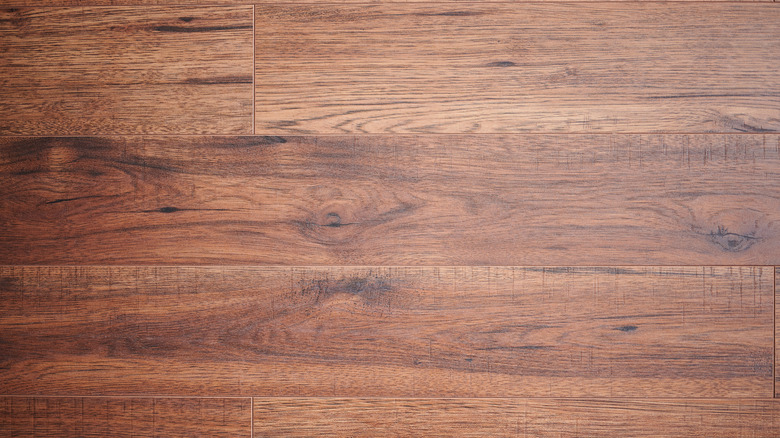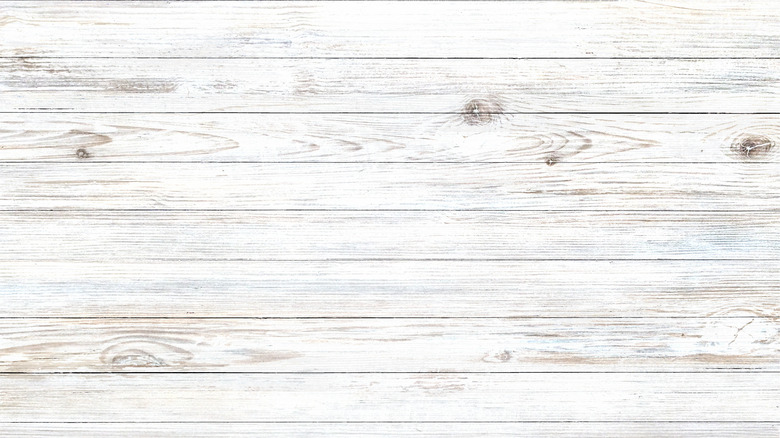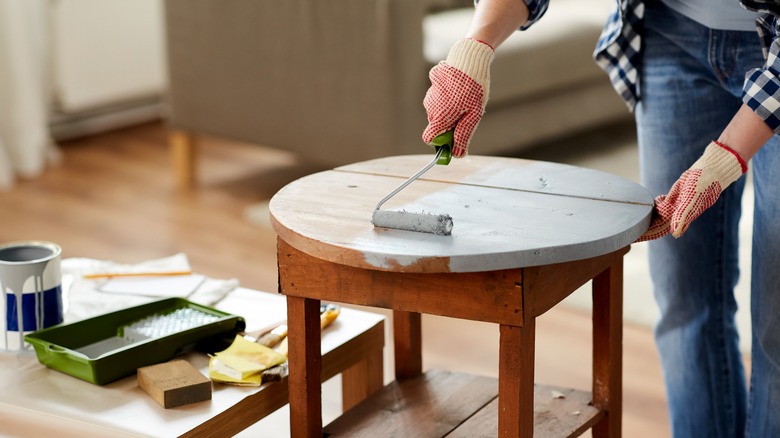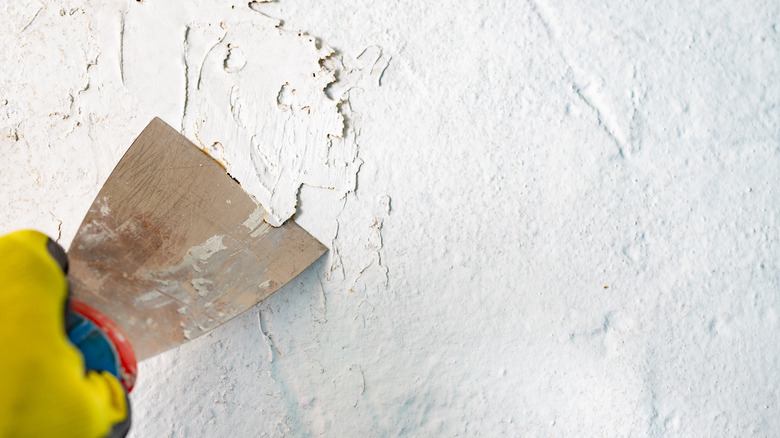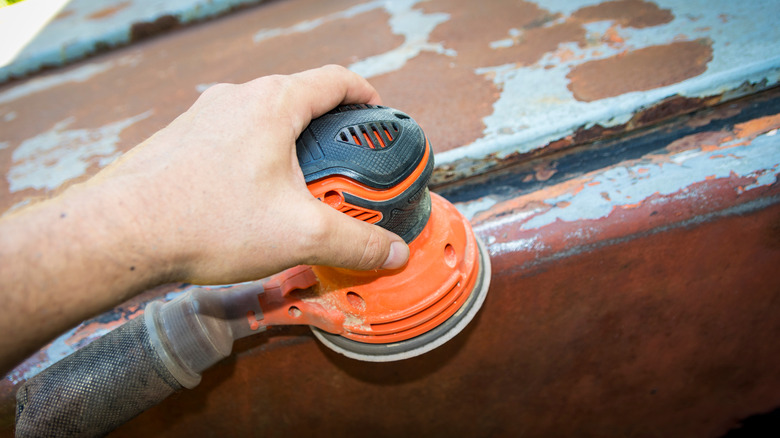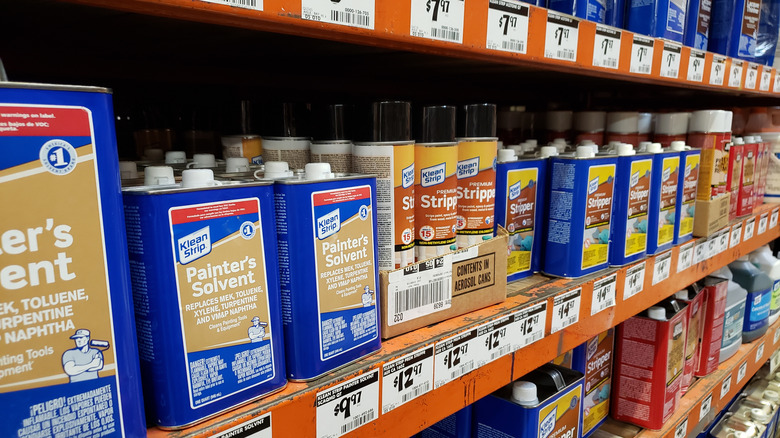The Best Way To Remove Dried Paint From Your Hardwood Floors
Hardwood floors are a staple in modern American homes. These additions are great for building a sense of comfort and luxury in a home, and they can go a long way to improving the resale value of the property as well, as per Homelight. But hardwood floors are susceptible to dripping paint from an interior repainting job, and they can even be painted themselves. Some homeowners apply water-based or latex paints directly onto their hardwood floors to create a unique element that changes the aesthetic of the feature in a dramatic fashion.
This doesn't mean that you'll always want the feature to appear that way though. Just like tile and carpeting changes, homeowners fall out of love with the way their wood floors look and feel over time. Making changes (even just as a point of maintenance) on occasion is an important process that will keep the home feeling fresh and modern. Painting hardwood flooring is a great way to make a substantial change after the element has lived in your home for many years.
Reversing the color is important for refurbishing the floors or returning them to their original state in an effort to market and sell the home. Whether you're trying to clean up after builders that left stains on flooring that's been covered over for years, removing dried color from a recent paint job on the walls, or changing the look of the planks, these methods can help you easily return your flooring to its natural look.
Determining the type of paint on your floor is crucial
Interiors Place notes that the first step to removing any paint from a surface that you want to protect (for instance, a hardwood floor plank) is the identification process. Water-based paints are some of the easiest to remove, and they are a favorite for painters and crafters alike, but you can't count on a paint substance that's stuck to your flooring to be an easy-to-remove variety.
While the removal process is similar for all of the primary paint types (water-based, latex, and oil-based paints), understanding what you're up against can help you select the most practical approach, saving time and protecting the flooring at the same time.
The best way to accomplish this task is by applying a bit of rubbing alcohol to a cotton ball and rubbing it against the surface that you are trying to clear. Rubbing in a small circle will either give you a small area in which the paint is starting to clear and lift, or it won't make a difference at all. In the event that you see no change after gently scrubbing the surface, you can be certain that you're dealing with oil-based paints. If you see a change, then the paint in question is either latex or water-based and won't require the same heavy-handed approach to removal.
Water-based paint can be scrubbed off with soap and water
For water-based paint, the best approach might be to use a solution of soap and water. This lifts the paint away and won't require a more physically demanding process of scraping and clearing away debris that can be painstaking and require a more significant application of elbow grease to complete, according to Rawlins Paints.
Soap and warm water should be used carefully, though. Too much liquid and you risk damaging the boards beneath the paint. Mixing soap and water in a large bucket and then carefully working your way across the floor from end to end can help you contain the watery solution and manage a thin coating of water on the wood surface. Floorboards are typically treated and can withstand some water applied to them, but you'll need to be careful to make sure you don't create a puddle that sits on top of the hardwood for an extended period. Soapy water is a great starting point for water-based paints. With a light touch and a consistent effort, quick and easy removal is within reach for most homeowners.
Soap and water can be all it takes to completely remove some newer paints, but for an older or trickier paint substance, this acts as a quality starting point to remove most of the color from your wood surface.
A paint scraper is a highly useful tool
A paint scraper or putty knife should be your next port of call when working against a particularly sticky paint situation. Some paint that's been in place for years (or pressed into the wood by the application of another flooring surface on top of the wood beneath) requires a more physical approach to completely clear away. Woodworking Clarity notes that a plastic putty knife or scraping device is desirable here because it will help you avoid scraping and scratching the wood beneath the paint. A plastic edge will remove the paint without damaging the surface beneath it.
Depending on your approach, starting with a paint scraper might be a good way to remove large strips of paint from the hardwood surface. Alternatively, if you're able to make use of soap and water, this can act as a secondary method that clears away any peskier sections of paint that didn't completely lift off with the less aggressive cleaning method.
This is best done on looser paint segments because they will have edges that are lifting, even if the entire section isn't already loose. Scraping under a loose edge will act like a zipper of sorts, continuing to rise the painted-over areas beyond it.
Sanding helps remove paint and prepare the surface for new finishing
Sanding the surface of your hardwood floors is another good option for removing paint. This is also the process of preparing the surface to refinish it with a new stain, or even a different paint color. Sanding a large surface like this is best done with an electric sander, according to Interiors Place.
An electric sander makes the job far quicker, and it can add a measure of uniformity to the sanding task that can be hard to duplicate with paper and physical exertion because of the speed with which a person sanding can become tired.
When sanding any wooden surface, it's best to begin with 60 grit sandpaper and then move higher in number. These figures correspond to the coarseness of the grain, and the higher the figure, the finer the finished product will be (via Grainger). Progressing higher up the scale will give you the abrasive power of lower grit and the smoothing capacity of higher grit paper combined.
Interiors Place reports that even after sanding thoroughly, you may need to return to certain spaces in the floor to sand them by hand or make use of a plastic scraper to finish off any grooves, ridges, or tight corners that the electric sander couldn't reach.
Rubbing or denatured alcohol (or another removal solvent) can finish a tough job
Finally, rubbing alcohol, denatured alcohol, or a more caustic paint removal solvent can be used for the most difficult jobs. These solutions make quick work of a painted surface, but you'll want to be careful while applying them. Family Handyman notes that when using solvents, it's often best to begin with another approach first, and then move on to this removal solution after you've exhausted other avenues. For water-based paints, Family Handyman suggests a solution of rubbing alcohol and lemon juice (three parts to one, respectively), allowing the mixture to sit and take effect on the painted surface for five minutes before scrubbing.
An oil-based paint may require a specialized solvent to get the job done. Sanding and scraping can be used successfully in many instances, but for tougher removal jobs, utilizing an oil-based removal solvent in the same way that you might apply a rubbing alcohol and lemon juice mixture will get the job done (via Interiors Place).
As with other paint types and methods, there's a good chance that you'll need to combine multiple methods to completely clear the hardwood floors of old paint. Taking the process slow and steady is the best way to ensure that you've completely removed all the paint leftover from an old job.

